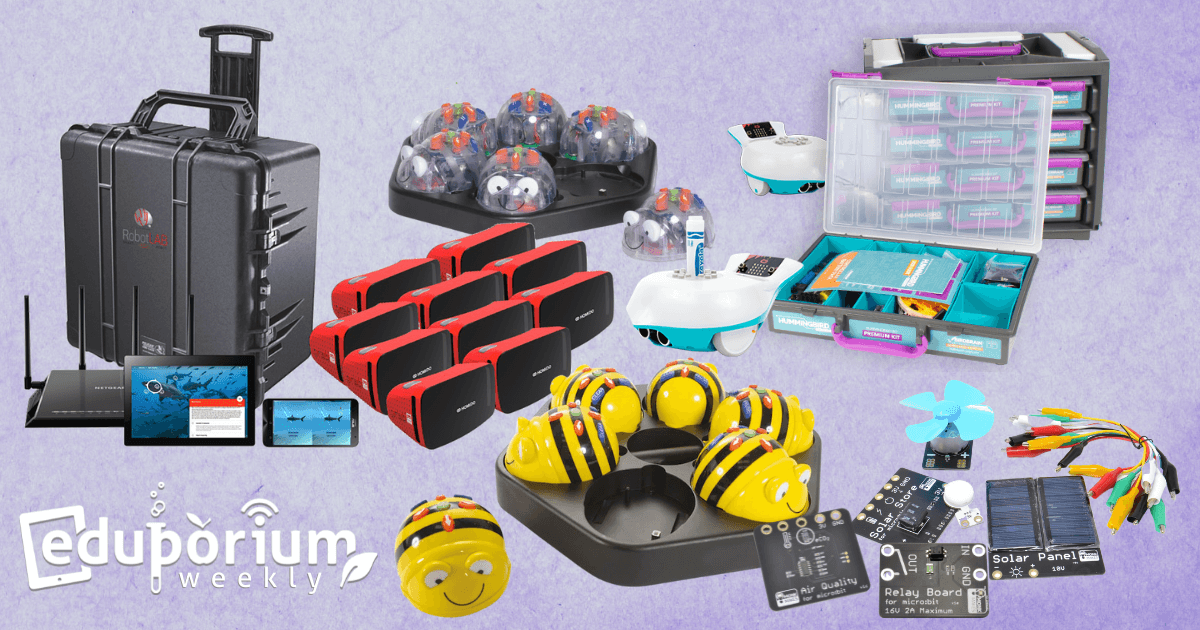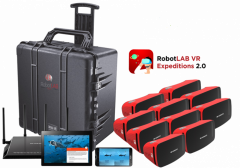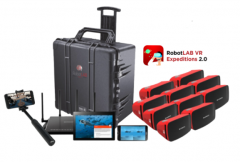Not many educators would argue that we still find ourselves in a unique period of education. While classroom instruction may be close to normal in some places, we know there's still a lot of work to do before every student feels like they've returned to pre-pandemic comfort levels. Even as supply chain disruptions continue to impact much of the technology world, we're continuing to do our part in introducing educators of all grade levels to new and effective STEM products that can impact student learning and development. In this week's post, we're helping you learn about a couple of new early education STEM tools we offer in the Bee-Bot and Blue-Bot, our latest virtual reality systems in the RobotLAB VR kits, some tinkering tools in the MonkMakes accessories, and a new robotics bundle in the Finch 2.0 Flock.
The Bee-Bot Robot
The Bee-Bot has emerged as one of the most recognizable and trusted early education STEM solutions. Not only is it an eye-catching learning tool, its shape and colors truly do mimic those of a bee. If you haven't caught any of the buzz surrounding using the Bee-Bot, much of it has to do with how it enables educators to teach coding and critical thinking skills to students as early on as Pre-K and kindergarten. The Bee-Bot is also viable in first and second grade classrooms thanks to some of its progressing features. The most notable of those features is that students can use it with or without a screen. This helps make it less intimidating at the Pre-K and kindergarten levels while also ensuring students in the early elementary grades have access to new features as they build the confidence in trying things that are a bit more complex.
The Bee-Bot and Bee-Bot See & Say.
The original Bee-Bot is one of those STEM products that have been around for the better part of a decade. Though there are now some updates to the original Bee-Bot version, the simplicity remains the same. The two Bee-Bot models are the original Bee-Bot and the Bee-Bot See & Say. The only difference between the two is that the See & Say Bee-Bot is Bluetooth-enabled. It's also just a $10 increase to move up to the See & Say option, which has proven to be a solid investment in early education classrooms. With either model, the programming process is essentially the same. Each Bee-Bot has four directional buttons located on its back. This is how students create programs and learn logic, sequencing, and even basic computational thinking skills in the process.
The STEM products in the Bee-Bot line.
Basically, all students need to do is clear the Bee-Bot's memory and then start pressing the directional buttons to create programs that involve the robot moving forward, backward, left, or right. For added inspiration, we also have digital Bee-Bot lessons on our store as well as other accessories. The Bee-Bot Learning Station, for example, includes a coding mat for the Bee-Bot to travel on. There's also the Bee-Bot Command Cards, which help students plan their program designs, the Bee-Bot Docking Station for neatly storing and charging robots, the Terrapin Robot Sensor for incorporating more advanced experiments, and the Bee-Bot Hive Bundle, which includes a Docking Station as well. To learn more about the Bee-Bot line or to request a quote, visit our store.
RobotLAB VR Expeditions 2.0 Kits
If you've used VR in the classroom, you may have caught wind that the longtime go-to option for educators, the Google Expeditions kits, are no longer usable. Back in June, the Google team discontinued its Google Expeditions app, leaving countless numbers of students and teachers without access to the immersive VR content many of them had grown to crave. Now, however, we're able to offer the RobotLAB VR Expeditions 2.0 kits as a legitimate alternative. These classroom VR kits look similar to the Google Expeditions kits and include many similar components. With six different options, educators can choose the one most conducive to leading high-definition field trips in their classroom.
Getting started with the RobotLAB virtual reality packs.
It appears to us that the RobotLAB VR kits will be the best Google Expeditions replacement. Especially for educators with experience using Google Expeditions, the transition should be fairly seamless. Even those new to teaching with tools like this, much of the work is done for them. The RobotLAB VR library contains over 700 immersive learning experiences on a huge variety of educational topics. Whether using VR in history classes, science classes, or in specialized areas, the content is certainly extensive. And, the student viewers come pre-loaded with the Expeditions 2.0 app to help make getting started even easier.
The RobotLAB STEM Products.
There are four RobotLAB virtual reality kits and two AR/VR kits. Each of the bundles can potentially serve up to 30 students and take them underwater, around the world, or down the street to places they've never been. Also, the Advanced Kits come with a different type of VR headset than the others. These standalone headsets are a bit more powerful and provide students with a 110-degree field of view and high-quality resolution. With the standard kits, students would use the red Homido VR viewers and still be able to enjoy 360-degree panoramas and see key points of interest along the way. The six RobotLAB VR Expeditions 2.0 kits can now be found along with the rest of the latest STEM products on our store.
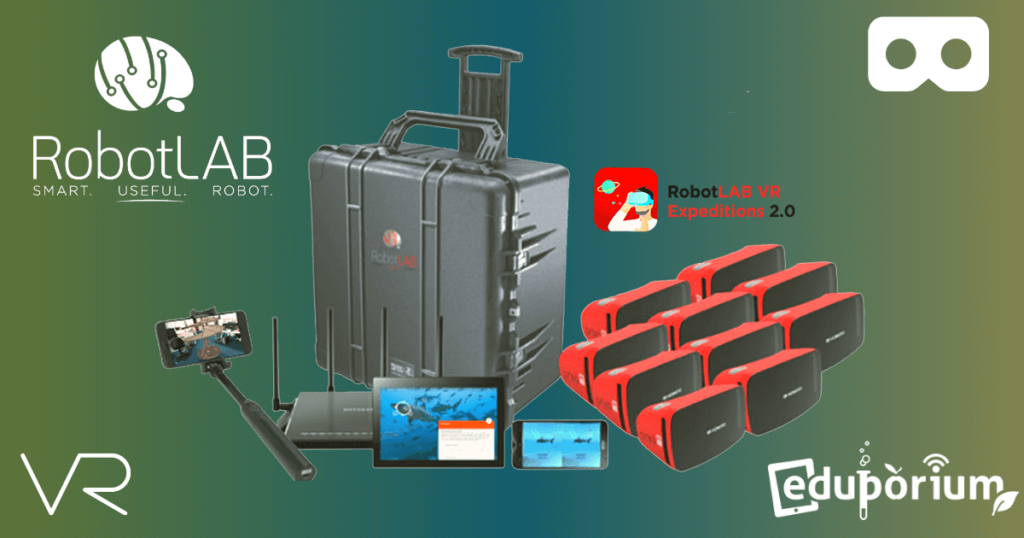
Finch Robot 2.0 Flocks
The Finch Robot 2.0 from BirdBrain Technologies has been out for a while now. There's no denying that, with its six modes of programming and unlimited versatility, it's one of our most recommended robotics tools and favorite STEM products in general. Now, these offerings have gotten even better with the release of the Finch Robot Classroom Flock. Their avian-inspired take on a classroom pack, the Classroom Flock essentially serves the same purpose. Teachers receive just about everything they need to facilitate Finch 2.0 lessons throughout the school day and make them work in any instructional environment. Plus, since the Finch 2.0 is relevant in every K-12 grade, this large-scale solution makes it easier to roll out.
What comes in the Flocks?
There are two options educators could choose from when purchasing Finch Flocks: with micro:bit's or without micro:bit's. As you may know, the micro:bit V2 is the Finch Robot's processor—it needs one in order to function. If educators already have micro:bit boards, that's great, but, if you need them, you can certainly select the appropriate option. The Flock comes with five Finch Robots and, if also purchasing micro:bit's, it comes with five of those as well. Besides these components, the Flock also comes with a USB charging hub specific to Finch Robots, a 5-pack of markers, and a robot carrying case that fits all five. It's even extremely compact and all the components fit nicely inside the case for easy transport and storage.
Finch 2.0 features, compatibility, and coding.
Students can use the BirdBrain STEM products individually or in groups of two or three. As you'll see following the link above, there are many standards-aligned activities they could try and many compatible programming languages students could explore. For the youngest students, FinchBlox is new to the Finch 2.0. It's icon-based and designed for pre-readers to interact with all the robot's features. These include an array of sensors, like line tracking, light, distance, and obstacle. Other languages include BirdBlox, MakeCode, Snap!, Python, and Java. Also, the Finch 2.0 is compatible with iOS, Android, Fire OS, Chrome, Mac, Windows, and Linux devices. It's all dependent on the programming language students are using.
The Blue-Bot Coding Robot
Don't worry—we're not only now offering the Bee-Bot robot. We have its companion, the Blue-Bot as well. The Blue-Bot is the same size and shape as the Bee-Bot but it has two distinct differences. The first is that its shell is completely transparent so that students can see inside. This helps spark their curiosity and inspires them to explore new things in the classroom. The other is that it's Bluetooth-enabled, which the original Bee-Bot is not. The Blue-Bot is about five years newer than the Bee-Bot and, mainly due to this Bluetooth functionality, it helps enable students in the early grades to take a big step in their computer science development. Like with many STEM products, this new wrinkle helps ensure they're always progressing.
A natural progression and transition.
Depending on their confidence levels, it's sometimes best to use the Bee-Bot with students first. Since it does not require a screen, they can start building programming and logic skills with a truly simplistic STEM product. Once they've mastered programming the Bee-Bot using its on-board directional keys, however, they can progress to coding with the Blue-Bot. Since it's Bluetooth-enabled, students can use the Blue-Bot app to create programs. Because the Blue-Bot is also designed for early education, it features the same directional and control buttons as the Bee-Bot. Only now, with the Blue-Bot app, students can create programs digitally using the same commands they're already familiar with. And, in the same way, once they've created programs, they can run them by pressing the go button.
The Blue-Bot STEM products.
Like the Bee-Bot, there are also some add-on options for teaching with the Blue-Bot. These mainly include the Blue-Bot Hive Bundle and the Blue-Bot Learning Station. We'll hopefully be able to offer more Blue-Bot accessories in the future but we hope this is a good starting point for educators for the time being. The Learning Station comes with either a Blue-Bot robot or a Blue-Bot See & Say robot and a card mat. The card mat provides a purposeful surface for students to use the Blue-Bot on and the See & Say Blue-Bot allows them to incorporate elements of sound and vision in their programs. Finally, the Hive Bundle comes with six Blue-Bot's, six decks of command cards, and a docking station for charging and storing all six robots. Head to the Terrapin section of our store to find it all.
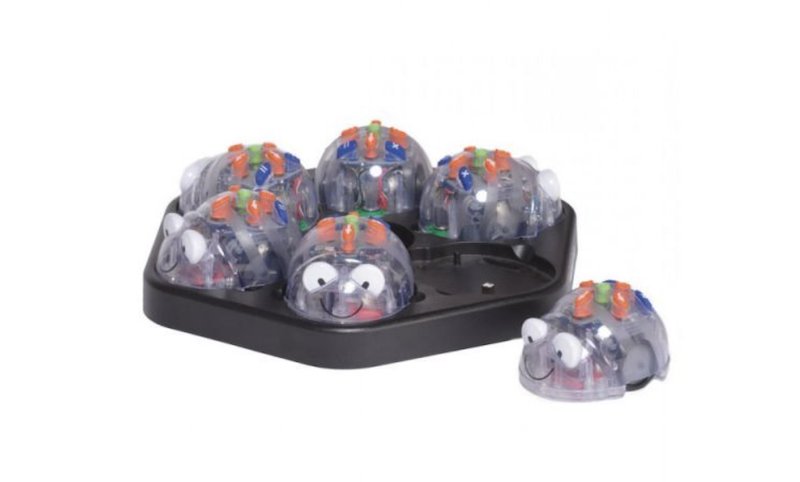
MonkMakes Kits and Accessories
The MonkMakes product line is one of the longest running offerings on our store. Going back to the Electronics Starter Kit for Raspberry Pi and some of their other robotics add-ons, these kits are great for active tinkering, prototyping, inventing, and, of course, programming. While the kits tend to run on the simple side in terms of materials, some of the challenges are actually pretty complex. They're typically intended for students in middle school and even high school—partly because the components are intricate and partly because they have some pretty specific uses. With these latest additions, however, we're now happy to offer 12 different MonkMakes kits on our store.
The MonkMakes STEM Products.
Most of the MonkMakes offerings are comprised of small kits with a specific scientific focus. There are also two accessories available: the 7-Segment for micro:bit and the Relay for micro:bit. Students can pair the 7-Segment board with a micro:bit board and use it to display numbers, letters, and other characters as part of their inventions. With the Relay for micro:bit, they can use a micro:bit board as an output to turn their inventions on or off. Besides those two interesting accessories, the complete kits can help expose students to new and interesting areas of STEM. Starting with the more robust, some of the new MonkMakes STEM products include the CO2 Sensor for micro:bit Kit, the Animatronic Head for micro:bit Kit, the Air Quality for micro:bit Kit, and the Solar Experiments for micro:bit Kit.
Covering niche areas of STEM.
With the CO2 Sensor Kit, students can measure temperature, humidity, and CO2 levels and incorporate those readings in projects. With the Animatronic Head Kit, they can build an animatronic head and devise a system for making the eyes move while projecting sound from a loudspeaker. As for the Air Quality Kit, the components work with the micro:bit and simply measure air quality in a room. Specifically, students can use the readings to determine how stale the air is. Finally, they can use the Solar Experiments Kit to harvest the Sun's energy and power devices with a solar panel. As you can see, these are some unique STEM products and that's just the beginning of the updated MonkMakes offerings. Some others include the Servo Kit for micro:bit, Charger Kit for micro:bit, Servo Kit for Raspberry Pi, and Air Quality Kit for Raspberry Pi. Here, you can find all our MonkMakes offerings.
For the latest EdTech, STEM, and 21st century education news, follow us on Twitter and Instagram. Like us on Facebook, too, or sign up for our newsletter for our latest product announcements and offerings. If you have an idea for an Eduporium Weekly theme, send us a message on social media or comment below.



